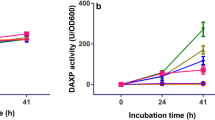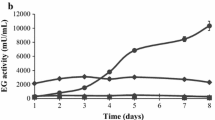Abstract
The production profile of cellulases of the mutant strain A19 from the filamentous fungus Stachybotrys microspora was studied in the presence of various carbon sources (glucose, lactose, cellulose, carboxymethylcellulose (CMC), and wheat bran) and a range of medium initial pH (5, 7, and 8). Two extracellular cellulases from the Stachybotrys strain (endoglucanases and β-glucosidases) were monitored by enzymatic assay, sodium dodecyl sulfate–polyacrylamide gel electrophoresis, and zymogram analysis. Glucose and lactose repressed CMCase time course production while they permitted a strong β-glucosidase one. On Avicel cellulose, CMC, and wheat bran, both activities were highly produced. Wheat bran (WB) is the best carbon source with an optimum of production at days 5 and 6. The production kinetics of both activities were shown to depend on the medium initial pH, with a preference for neutral or alkaline pH in the majority of conditions. The exception concerned the β-glucosidase which was much more produced at acidic pH, on glucose and cellulose. Most interestingly, a constitutive and conditional expression of an alkaline endoglucanase was revealed on the glucose-based medium at an initial pH of 8 units. The zymogram analysis confirmed such conclusions and highlighted that carbon sources and the pH of the culture medium directed a differential induction of various endoglucanases and β-glucosidases.








Similar content being viewed by others
References
Alper, H., & Stephanopoulos, G. (2009). Nature Reviews Microbiology, 7, 715–723.
Carroll, A., & Somerville, C. (2009). Annual Review of Plant Biology, 60, 165–182.
Belghith, H., Ellouz-Chaabouni, S., & Gargouri, A. (2001). Journal of Biotechnology, 89, 257–262.
Anish, R., Rahman, M. S., & Rao, M. (2007). Biotechnology and Bioengineering, 96, 48–56.
Ibarra, D., Concepción, M., Angeles, B., Martínez, B. A. T., & Martínez, M. J. (2012). Journal of Industrial Microbiology and Biotechnology, 39, 1–9.
Bhat, M. K. (2000). Biotechnology Advances, 18, 355–383.
Karmakar, M., & Ray, R. R. (2011). Research in Microbiology, 1, 41–53.
Xiong, H., Weymarn, N. V., Leisola, M., & Turunen, O. (2004). Process Biochemistry, 39, 729–733.
Sohail, M., Siddiqi, R., Ahmad, A., & Khan, S. A. (2009). New Biotechnology, 25, 437–441.
Junqi, Z., Pengjun, S., Zhongyuan, L. I., Peilong, Y., Huiying, L., Yingguo, B., et al. (2012). Bioresource Technology, 121, 404–110.
Ahamed, A., & Vermette, P. (2009). Bioresource Technology, 100, 5979–5987.
Mello-de-Sousa, T. M., Ildinete, S. P., & Marcio José, P. F. (2011). Enzyme and Microbial Technology, 48, 19–26.
Saibi, W., & Gargouri, A. (2013). Applied Biochemistry and Biotechnology, 6, 1725–1732.
Amouri, B., & Gargouri, A. (2006). Biochemical Engineering Journal, 32, 191–197.
Saibi, W., Amouri, B., & Gargouri, A. (2007). Applied Microbiology and Biotechnology, 77, 293–300.
Brini, F., Saibi, W., Amara, I., Gargouri, A., Masmoudi, K., & Hanin, M. (2010). Bioscience Bitechnology Biochemistry, 74, 1050–1053.
Mandels, M., & Weber, J. (1969). Advances in Chemistry Series, 95, 391.
IUPAC (International Union of Pure and Applied Chemistry). (1987). Pure and Applied Chemistry, 59, 257–268.
Bradford, M. M. (1976). Analytical Biochemistry, 72, 248–254.
Laemmli, U. K., & Favre, M. (1973). Journal of Molecular Biology, 80, 575–592.
Ruijter, G. J., & Visser, J. (1997). FEMS Microbiology Letters, 151, 103–114.
Foreman, P. K., Brown, D., Dankmeyer, L., Dean, R., Diener, S., Dunn-Coleman, N. S., et al. (2003). Journal of Biological Chemistry, 34, 31988–31997.
Abdul Razak, M. N., Ibrahim, M. F., Yee, P. L., Hassan, M. A., & Abd-Aziz, S. (2012). Biotechnology and Bioprocess Engineering, 17, 547–555.
Mehdi, D., Heidi, S., & Wensheng, Q. (2009). International Journal of Biological Sciences, 6, 578–595.
D-Souza, J., & Volfova, O. (1982). Applied Microbiology and Biotechnology, 16, 123–125.
Singh, A., Singh, N., & Bishnoi, N. R. (2009). International journal of Environmental Science and Technology, 1, 23–26.
Schiilein, M. (1997). Journal of Biotechnology, 57, 71–81.
Morikawa, Y., Ohashi, T., Mantani, O., & Okada, H. (1995). Applied Microbiology and Biotechnology, 44, 106–111.
Saibi, W., Abdeljalil, S., & Gargouri, A. (2011). World Journal of Microbiology and Biotechnology, 27, 1765–1774.
Immanuel, G., Bhagavath, C. M. A., Iyappa, R. P., Esakkiraj, P., & Palavesam, A. (2007). International Journal of Microbiology, 3, 1–7.
Saqib, A. A. N., Hassan, M., Khan, N. F., & Baig, S. (2010). Process Biochemistry, 45, 641–646.
Soni, R., Nazir, A., & Chadha, B. S. (2010). Industrial Crops and Products, 31, 277–283.
Acknowledgments
Lamia Jmal-Hammami and Mosbeh Dardouri are thanked for their technical help. We thank Professors Raja Mokdad-Gargouri and Hafedh Belghith for the fruitful discussion of scientific interpretations. This work was supported by grants from the Ministry of Higher Education and Scientific Research, Tunisia.
Author information
Authors and Affiliations
Corresponding author
Rights and permissions
About this article
Cite this article
Hmad, I.B., Abdeljalil, S., Saibi, W. et al. Medium Initial pH and Carbon Source Stimulate Differential Alkaline Cellulase Time Course Production in Stachybotrys microspora . Appl Biochem Biotechnol 172, 2640–2649 (2014). https://doi.org/10.1007/s12010-013-0705-1
Received:
Accepted:
Published:
Issue Date:
DOI: https://doi.org/10.1007/s12010-013-0705-1




